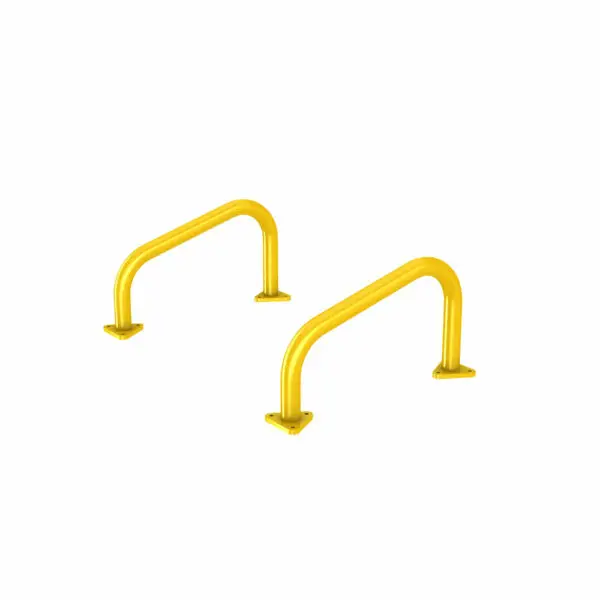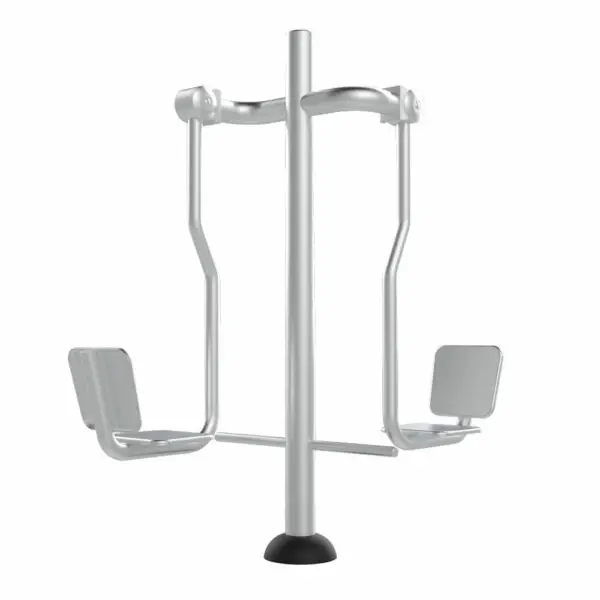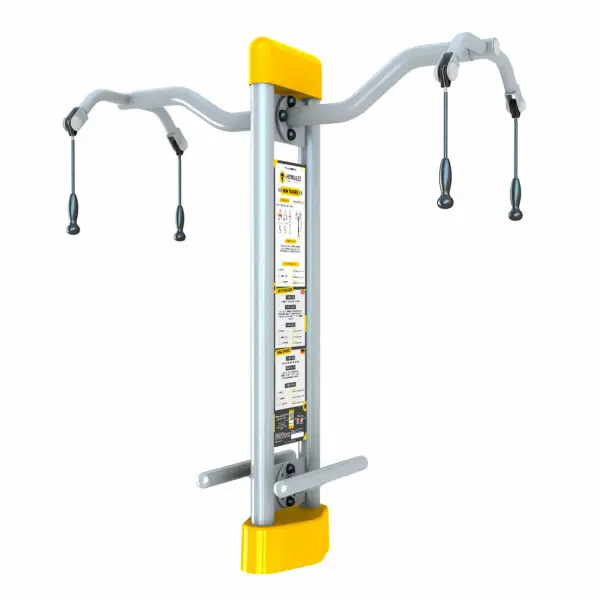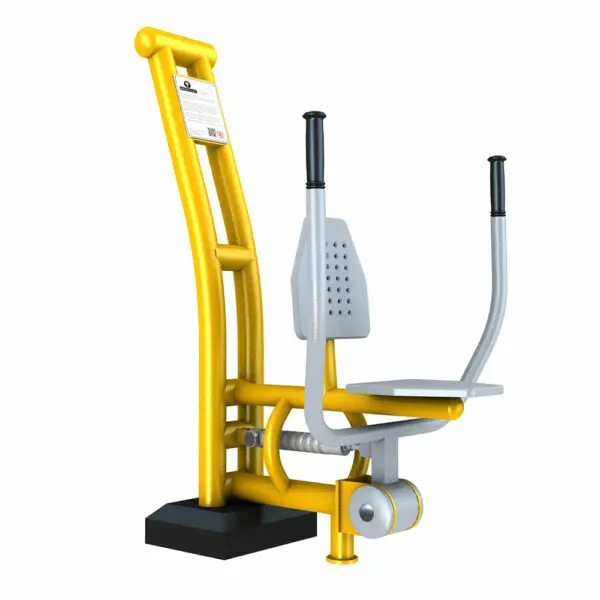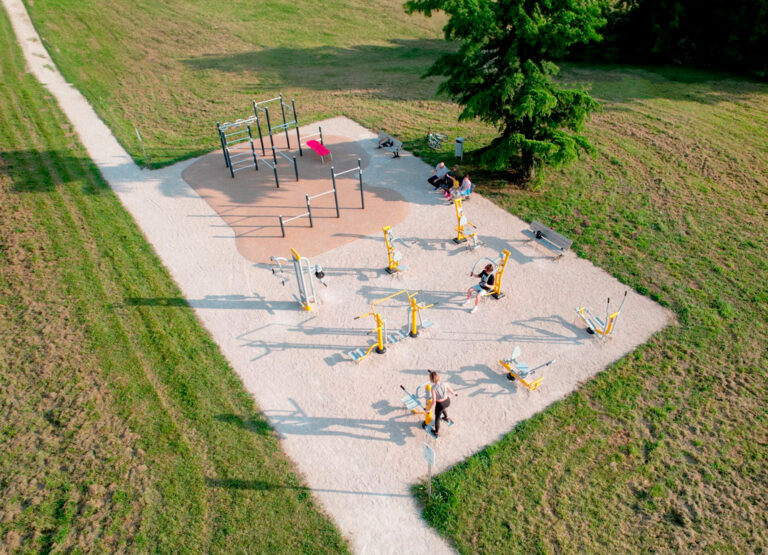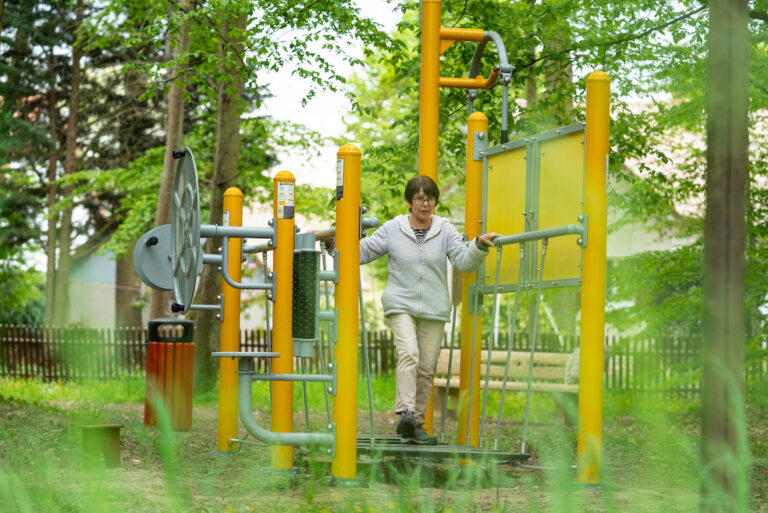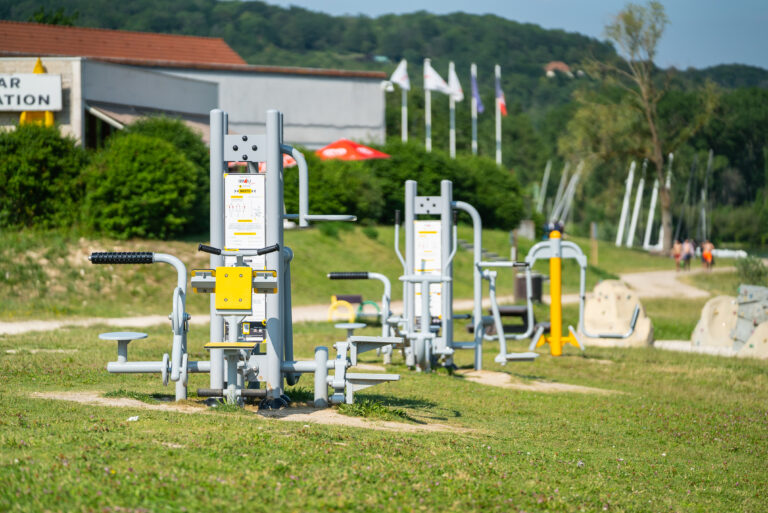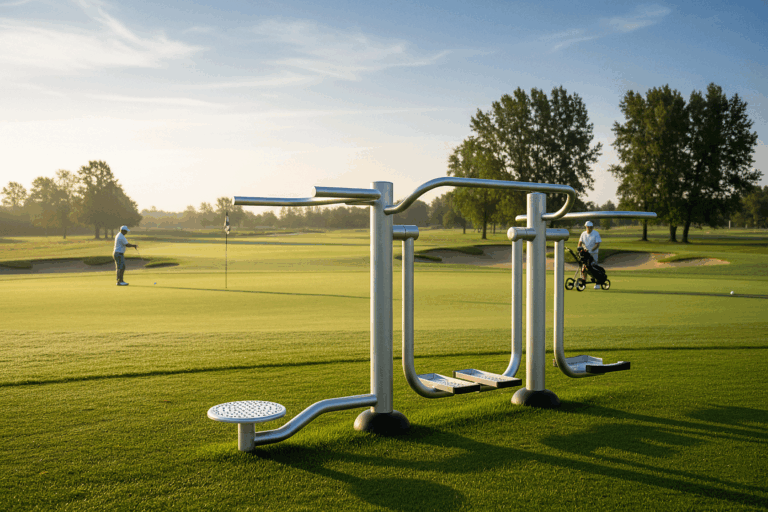Introduction
The outdoor fitness craze
In recent years, outdoor fitness has boomed. Whether in city parks, public gardens or on school campuses, outdoor sports facilities are multiplying. Several factors are behind this craze:
- Growing awareness of the importance of physical activity for health, particularly in the fight against sedentary lifestyles and obesity.
- A need for conviviality and social ties, reinforced by the fact that you can train in the great outdoors, without the constraints of subscriptions or schedules.
- Multi-functional spaces: street workout areas, body-weight machines, cardio and strength stations designed for all ages and levels.
For local authorities, schools and businesses alike, investing in an outdoor fitness project offers many advantages. It enhances the well-being of the population, energizes public spaces, and promotes the image of a community or institution focused on health and conviviality, which is why we’re going to detail the subsidies available for an outdoor fitness project.
Financing issues
Despite the growing interest in this equipment, an outdoor fitness project represents a substantial investment. The budget includes not only the purchase and installation of equipment, but also landscaping and flooring (shock-absorbing surfacing, lighting, etc.).
- For local authorities, this often involves a complex budgetary trade-off: should other projects be abandoned to finance these sports facilities?
- For schools and universities, subsidies and partnerships are crucial to providing students with a safe and sustainable sports facility.
- For companies, financing an outdoor fitness area can be part of a corporate social responsibility (CSR) or workplace well-being initiative, but requires a balance between costs and benefits.
In this context, identifying and mobilizing grants and subsidies is essential. Fortunately, there is a wide range of schemes available to support the creation of outdoor sports facilities, both public and private.
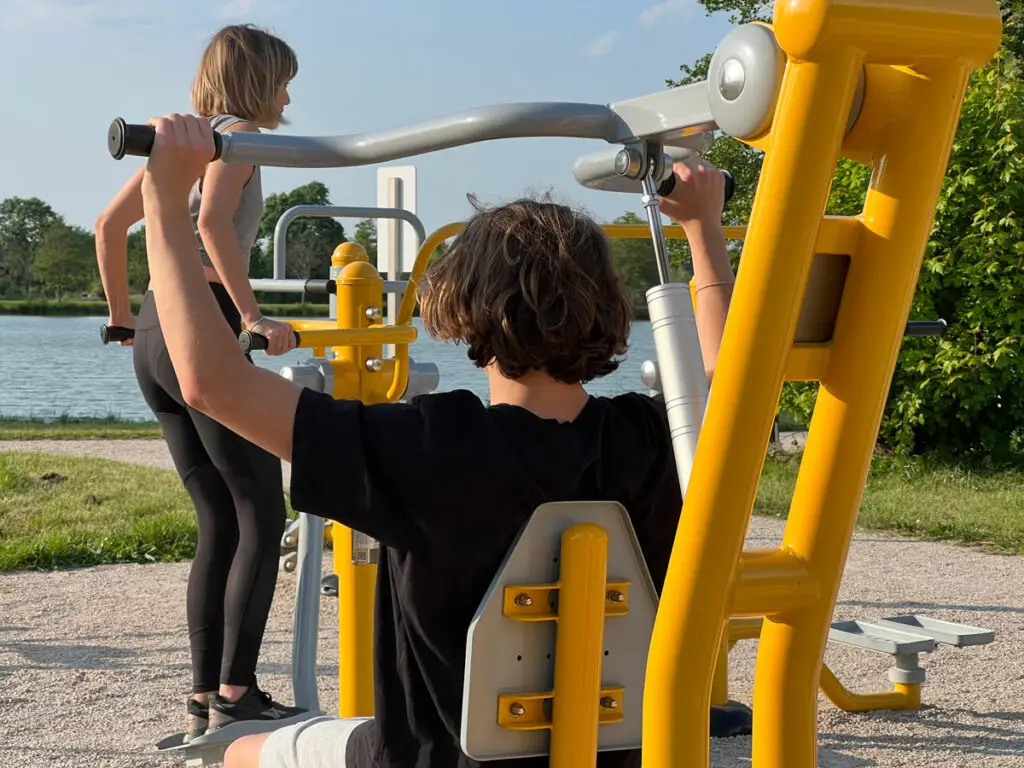
Public subsidies: national, regional and local
When it comes to financing an outdoor fitness project, the first thing to do is turn to public subsidies. These are based on public policies designed to encourage the practice of sport, combat sedentary lifestyles and improve local quality of life. In this section, we will distinguish between national schemes, regional and departmental subsidies, and local initiatives such as participatory budgets or calls for inter-municipal projects.
National systems
National Sports Agency (ANS)
In France, theAgence Nationale du Sport (ANS ) is one of the main funding levers for sports projects. It is the result of a transformation of the former CNDS (Centre National pour le Développement du Sport), and works in partnership with the French government, the sporting movement and local authorities.
- Objective: The ANS aims to support the practice of sport for all, in particular through the development of local facilities. Outdoor fitness areas fit perfectly into this framework, as they encourage independent practice, free of charge and accessible to as many people as possible.
- Eligibility criteria:
- The general interest of the project (increasing the range of sports on offer, combating sedentary lifestyles, facilitating access to sport).
- Consistency with local public policies and the local sports charter.
- Target audience (priority given to young people, people who are far removed from sporting activities, etc.).
- Amounts and terms: Subsidies may vary according to the level of priority and the annual budget allocated by the ANS. The agency often co-finances a percentage of the total eligible amount (between 20% and 60%), in addition to other partners (local authorities, sponsors, etc.).
Practical tip: regularly consult the ANS website and the circulars relating to calls for projects. Funding criteria can change from year to year, and it’s crucial to submit your application on time.
Other ministerial programs
In addition to the ANS, certain ministries or government bodies offer specific calls for projects or budget envelopes from time to time:
- French Ministry of Sports Can launch or relay initiatives to promote physical activity outdoors, particularly as part of the “Sport Santé Bien-Être” program.
- French Ministry of Health Ministry of Health: Focuses on actions to prevent obesity and chronic disease through sport. Funding may be granted to projects focusing on public health.
- French Ministry of Education : Within the framework of school sports and educational projects, funds can be mobilized to equip a school or university campus with outdoor sports facilities.
These programs are more specific and thematic than those of ANS.
Regional and departmental subsidies
Beyond the national level, each region and department has its own policy for supporting sports projects, with varying priorities and procedures.
Regional Councils
Regional Councils are playing an increasingly important role in the development of local sport. They can offer :
- Facilities development grants: Reserved for local authorities, schools or even associations with a project of general interest.
- Incentives linked to the fight against sedentary lifestyles and the promotion of sports tourism. One region, for example, is banking on the concept of “nature sports resorts” to diversify its tourism offering.
- Territorial criteria: Some regions give priority to rural areas, priority urban districts or under-equipped geographical sectors.
Example: The Conseil Régional d’Occitanie (France) has set up a fund to support innovative sports projects, including the creation of fitness areas in towns with fewer than 10,000 inhabitants.
Departmental Councils
The Départements (or Departmental Councils) often complement regional action by supporting :
- Local facilities: fitness trails, playgrounds and fitness centers for family and intergenerational use.
- Educational projects: for example, the creation of sports courses for secondary school pupils.
- Associative initiatives: local sports clubs wishing to develop infrastructures accessible to the general public.
The amounts awarded vary according to the department’s political orientations and budgetary margins. To apply, it is generally necessary to submit an application to the department in charge of sports and youth, justifying the interest of the project for the area.
Municipal and inter-municipal initiatives
Participatory budgets
More and more towns and cities are introducing participatory budgets, enabling residents to propose and vote on projects of collective interest. The installation of outdoor fitness equipment fits perfectly into this logic, as it involves :
- Improve the living environment and accessibility to sport.
- Strengthen the collaborative approach: citizens, associations and municipalities work together to build the project.
If your commune has a participatory budget, you can submit a file detailing :
- Planned installation location.
- Estimated cost (purchase, installation, maintenance).
- Target audience and expected benefits (health, social ties, etc.).
If the project receives enough votes, it will be allocated a dedicated budget.
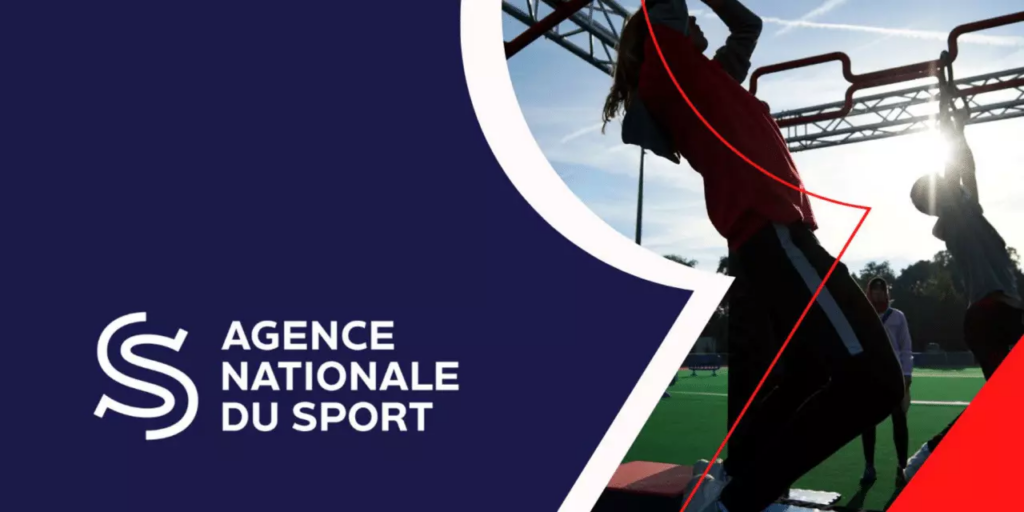
European funding: an often overlooked opportunity
The funds and programs of the European Union (EU) also offer significant opportunities for financial support for projects linked to sports practice, inclusion and innovation. Often overlooked or considered too complex, these schemes can nevertheless be a decisive lever for financing an outdoor fitness area, particularly if your project has educational, social or cross-border dimensions.
Structural Funds (ERDF, ESF, etc.)
General presentation
The European Union provides Structural Funds, the two main ones being :
- ERDF (European Regional Development Fund) The European Regional Development Fund (ERDF) is designed to support initiatives aimed at stimulating the regional economy, territorial cohesion and innovation.
- ESF (European Social Fund) focuses more on employment, training and social inclusion.
In some cases, an outdoor fitness project can be part of a broader local development strategy, highlighting :
- Improving the quality of life in disadvantaged rural and urban areas.
- The social dimension: installation of free sports facilities open to all, including vulnerable groups (young people, senior citizens, people far removed from sport).
- A tourism or economic dimension: attracting visitors, boosting the local economy (shops, hotels, etc.).
The regions often manage part of the ERDF and ESF via operational programs. Priorities vary according to regional orientations: rural development, the fight against unemployment, social cohesion actions, and so on. It is therefore advisable to contact the relevant regional or localManaging Authority for specific criteria.
Eligibility criteria and how to apply
To qualify for these European funds, it is essential to prepare a rigorous file that highlights :
- Whether the project is in line with the objectives of the operational program (e.g. inclusion, health, attractiveness of the region).
- Innovative or structuring character: in what way does the installation of an outdoor fitness area constitute an asset for the region (creation of social links, improvement of image, strengthening of cohesion)?
- Financial viability: overall financing plan, public and private partnerships, maintenance and animation forecasts.
Response times can be longer than at national level. Several months (or even a year) must be anticipated between submission of the application and actual receipt of funding. In addition, the ERDF and ESF do not generally intervene on their own: they co-finance a project, alongside other subsidies (regional, departmental, SLA) and private contributions or those of the project owner.
Cross-border or interregional cooperation programs
Interreg and similar schemes
The program Interreg is an EU program that encourages cooperation between European countries and regions, particularly for projects aimed at strengthening economic and social cohesion. Sports projects, if they create a cross-border dynamic (e.g. collaboration between two neighboring municipalities in different countries), can benefit from this type of support.
- Interreg Europe Supports the exchange of best practices and joint actions between European regions.
- Interreg transfrontalier (e.g. France-Spain, France-Belgium, France-Italy): Encourages the implementation of shared projects designed to enhance the value of territories, improve mobility or health.
In this context, an outdoor fitness area can be integrated into a larger project, such as a “cross-border sports trail” or a “soft mobility circuit” linking several localities. In such cases, the innovative and collaborative aspect will be decisive in justifying an application for funding.
Timetable and procedures
Each Interreg program (or other cooperation program) follows a specific timetable, with regular (often annual or biannual) calls for projects. To apply :
- Look out for the dates of publication of calls for proposals on the official Interreg or European Commission websites.
- Contact the regional office or coordinating structure to obtain an initial opinion on the project’s eligibility.
- Set up the consortium: in general, you need at least two partners from different countries or regions.
- Write up the dossier, emphasizing cooperation, European added value, anticipated impact on the region, target audiences, etc.
Interreg projects can cover a large part ofthe budget (up to 60-80% of the total eligible cost), but require serious administration and strict management (justification of expenditure, regular reporting). However, if your project is successful, the financial leverage is considerable.

How to prepare an effective grant application
Obtaining funding, whether from public bodies, private foundations or European programs, requires a solid and convincing application. For an outdoor fitness project, this means demonstrating the relevance of the development, its positive impact on the population, and the credibility of the financial plan and organization. In this section, we detail the key elements of a successful grant application.
Clearly identify objectives and target audience
Which populations will benefit from the equipment?
First and foremost, it is crucial to define who is affected by your project:
- Age range: are we targeting teenagers, working adults, seniors, or an intergenerational audience?
- Sporting levels: will the site be suitable for beginners, experienced athletes or both?
- Local specifics: is the area rural (with few sports facilities) or urban (with a high population density)? Is there a priority district nearby, or any interested schools?
By answering these questions, you demonstrate that your outdoor fitness project meets concrete needs. Financial backers (local authorities, foundations, sponsors) often give priority to initiatives that target groups far removed from the practice of sport (the elderly, school drop-outs, etc.) or that contribute to equal opportunities (lack of facilities in certain areas).
Measuring expected impact
A good dossier must illustrate the general interest of the project by providing tangible data:
- Local statistics: sedentary lifestyle, prevalence of obesity, lack of sports facilities in the area.
- Studies or surveys: surveys conducted among future users to validate their motivation and identify their needs.
- Expected spin-offs: increase in the number of people practicing sports, revitalization of a neighborhood, strengthening of social ties.
The more factual elements you put forward, the more serious and coherent your dossier will appear. This will also help you anticipate success indicators (estimated number of users, frequency of use, etc.), which will be invaluable in assessing the impact once the space has been inaugurated.
Present a detailed, realistic budget
Breaking down costs
Funders appreciate clear and transparent financial information. Detail each item of expenditure:
- Feasibility study: site diagnosis, development plans, architect or design office fees.
- Purchasing equipment: unit cost of fixtures, any transport costs, choice of materials (steel, stainless steel, etc.).
- Installation work: earthworks, anchoring, shock-absorbing flooring, signage, etc.
- Long-term maintenance: forecasts for maintenance (checking fasteners, cleaning, repairs).
By structuring your budget in the form of a table or list of figures, you show that you have taken into account all the stages and potential costs involved. This reassures the funder of the credibility of your approach and avoids unpleasant surprises.
Show financing breakdown
Specify who finances what:
- Equity: the amount invested by the community, association or company behind the project from its own internal resources.
- Expected subsidies: name of schemes (Agence Nationale du Sport, Conseil Régional, European funds, etc.), amount requested and percentage of co-financing.
- Private partnerships: patronage, sponsorship, in-kind donations, crowdfunding.
- Other resources: bank loans, income from sporting events, etc.
Funders like to see a leverage effect: the more you are able to diversify your funding sources, the more you will give the impression of a solid, shared project. Don’t forget to include a cash flow plan to anticipate the period between the signing of agreements and the actual receipt of subsidies.
Gather all supporting documents and meet deadlines
Essential parts
The file is often accompanied by administrative annexes:
- Plans and visuals: sketches, 3D simulations, precise positioning of equipment.
- Quotations and pro forma invoices: to justify the amounts announced.
- Statutes of the supporting structure (association, local authority, company) and legal documents: RIB, SIRET, municipal council decisions, etc.
- Letters of support: testimonials from sports associations, clubs, local residents and other partners.
The more complete and meticulous your application, the less risk of delays or rejections during processing.
Keeping to schedule
Each funder (region, national agency, European fund, etc.) has deadlines for submitting applications. It is therefore essential to :
- Anticipate: start preparing your application several months before the closing date of the call for projects or grant campaign.
- Stay informed: sign up for newsletters or alerts from funding bodies, and check their official websites regularly.
- Follow up on reminders: after submission, be available to provide any additional information, adjust your budget or answer questions from the appraisal committee.
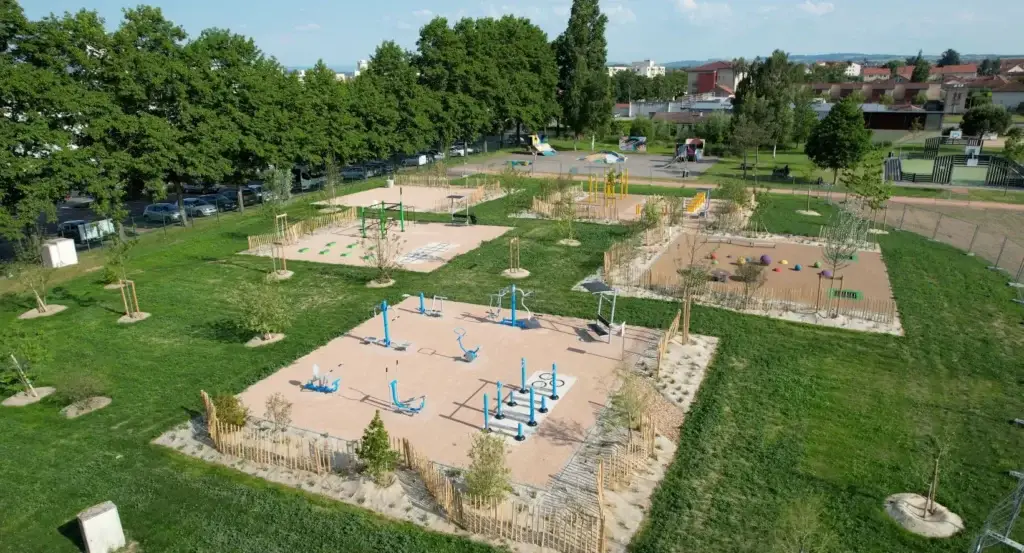
Conclusion
Outdoor fitness is winning over more and more local authorities, schools and businesses, but financing it can be complex. To make your project a success :
- Multiply your sources of funding: apply for public subsidies (Agence Nationale du Sport, regions, départements), explore European funds (FEDER, Interreg), and consider private patronage or sponsorship.
- Think participatory financing: participatory budgets strengthen citizen support and can supplement institutional aid.
- Take care with your application: demonstrate the social and sporting benefits, give precise costings (purchase, installation, maintenance), and highlight the eco-responsibility of the project.
- Bring together local players: associations, businesses, schools… Everyone can contribute financial, material or logistical support.
Need help making your outdoor fitness project a reality or putting together a solid file? Contact us at now: we’ll be delighted to help you find the right combination of financing to match your ambitions.

